|
The Nicholas Brothers
by Mike Dicecco
Fayard and Harold Nicholas dancing in the film
Sun Valley Serenade,
January 10, 1941.
Image by Corbis - Bettmann
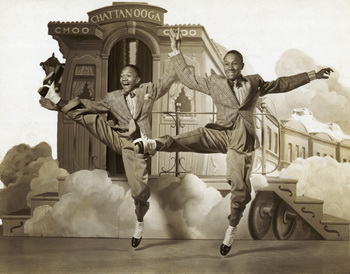
|
|
Our January 12th, 2025 CAPS meeting began with a
presentation I did about The Nicholas Brothers. I began by asking the audience how many had heard of
this act before. Approximately one third of the group
answered in the affirmative, which was unfortunately
not surprising. I will look at some of the reasons for
this modern day obscurity in my write up.
The article that follows is a summary of what I covered, along with links to the video clips. It cannot be
emphasized too strongly how beneficial it will be for
the reader to view these clips, as no words alone could
ever accurately describe the talent and dexterity these
two gentlemen had. I guarantee you’ll be totally
amazed!
In this article I will give an outline of their lives, career
highlights, and provide some video links to the best
examples of their routines.
The Nicholas Brothers were a duo composed of Fayard
and Harold Nicholas who excelled at highly acrobatic
dance and singing routines mainly between the 1930’s
and early 1950’s. However, they continued performing into the late 1990’s! Their style of dancing is sometimes referred to as “flash dancing” and they are considered to be the greatest tap dancers of their day, if
not of all time! The duo was composed of older brother, Fayard (1914-2006) and the younger Harold (1921
-2000).
Fayard Nicholas (top) 1914-2006, Harold Nicholas
(bottom) 1921-2000,
with Their Mother, Viola
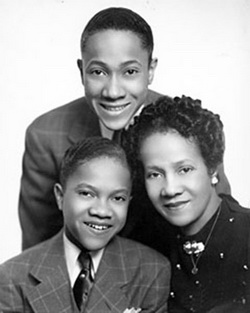
|
|
My exposure to the brothers came in the early 1970’s
when I saw the 1942 movie “Orchestra Wives” on TV. I
had watched it mainly because of Glenn Miller’s orchestra, but I was thoroughly amazed at two performers who appeared at the climax of the movie. Their
dance routine was incredible! They began by adding
additional singing verses to Glenn Miller’s piece and
then broke into a wild dance routine that had them
literally bouncing off the walls! Who were these guys?
It was only a couple of years ago that I discovered who
these acrobatic dancers were, and through the magic
of You Tube their performances are available at the
click of a button today. My research indicated that the
Nicholas Bros. possessed extreme natural talent, and
were recognized via the many awards and venues that
they performed at. In total they danced for 9 different
USA presidents and even the King of England in 1948. They have a star on the Hollywood Walk of Fame, and
their many awards are too numerous to mention here.
A countless number of films and television appearances were also made. However in spite of all these
achievements the Nicholas Brothers had to endure
much of racism’s degrading treatment as well as attitudes which in some ways hampered their career and
providence. Still, they overcame and paved the way for
future black performers that continue to benefit to this
day.
Fayard Nicholas was born in Mobile Alabama in 1914
and younger brother
Harold in North Carolina in 1921. Their
mother Viola was a
pianist and their father Dominick a
drummer. Both parents were college-
educated musicians
who played in their
own band at the
Standard Theater,
when the family relocated to Philadelphia
in 1926. At an early
age the brothers
would often be in the
front row of the theater and be fascinated
by the combination of
tap dancing and acrobatics that they would see (and
later imitate).
One of their few 78 rpm records from 1936
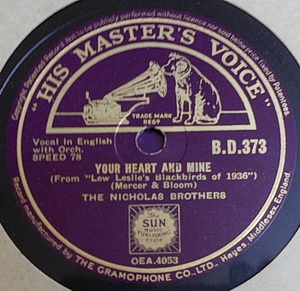
|
|
The Standard was owned by entrepreneur John T. Gibson who brought in some of the most talented African-
American performers, jazz musicians and vaudeville
acts of the 1920’s. The young Nicholas boys were able
to view top notch acts such as Bessie Smith, Ethel Waters, Louis Armstrong, and Duke Ellington among many
others of the period. What a fabulous way to start a
musical education!
Neither had any formal dance training. Fayard
taught himself how to sing and dance by watching and then repeating what they saw at The
Standard. His father told him that it was fine to
copy other performers, but he had to then add
something original to make it uniquely his own.
Other good advice was: “Don’t look at your feet,
look at the audience”. Fayard then taught his sister Dorothy several routines and younger Harold
would join in and then perform as the “Nicholas
Kids”. Dorothy later dropped out of the act
(around 1928), and the two simply became
known as “The Nicholas Brothers”. They were
both relatively short in stature: Fayard was 5’4”
and Harold only 5’2” as adults, but this did not
limit their abilities. Their parents realized the talent the two boys possessed, so they decided to
quit their jobs and manage them instead.
Their rise to stardom was quite fast: word spread
throughout Philadelphia and they soon began
performing at various theatres around town. They
became the featured act for two years at Harlem’s Cotton Club in 1932 when Fayard was 18
and Harold 11 years of age. They would perform with legendary black orchestras such as Lucky
Millinder, Cab Calloway, Eubie Blake, Duke Ellington
and Jimmy Lunceford.
It was while they were at the Cotton Club in 1932 that
they were signed to make their first movie, a short for
Vitaphone called “Pie, Pie, Blackbird” featuring Eubie
Blake & his Orchestra. Even though they were arguably
the highlight of the film (being the last act), their performance was uncredited. Lanky Fayard was 18 at the
time, and you’ll notice his smiling pride as his 11 year
old sibling just steals the show with his dance moves.
It’s just amazing to see the talent that this eleven year
old child had. The video clip is available here: https://www.youtube.com/watch?v=XwMC3Tgtuyk
Their first big Hollywood break came when Samuel
Goldwyn saw them perform at the Cotton Club and they
were given an invitation to come to California to be
part of a new movie called “Kid Millions” (1934). The
film had a fully Caucasian cast in it, with lots of leggy
dancing girls, and featured Ethel Merman and Eddie
Cantor in the lead roles. It climaxes with a minstrel
show being put on for a white audience, with Eddie in
“black face”. He tries dancing with the Nicholas Bros,
who easily outperform him to the point where he
leaves the stage and they take over to amaze the
crowd. By today’s standards parts of the film would be
viewed as incredibly racist, but it was perfectly acceptable in 1934. The video clip is available here:
https://www.youtube.com/watch?v=3osyeKcLuJs
By the mid 1930’s the Nicholas Brothers were becoming well known. An interesting event occurred one day
through a chance meeting with their idol, Fred Astaire,
on the back lot of RKO studios. The three started going
into dance routines right in the parking lot. Fortunately
their mother Viola was with them and had her home
movie camera to document the encounter. It was totally ad lib, and demonstrated the natural talent they all
had. The video home movie is available here: https://www.youtube.com/watch?v=tOfPJ28BxIk
Their popularity really seems to have taken off in the
mid 1930’s. They usually appeared in two to three
films per year up until the late 1940’s (in addition to
often being the star act at many theatres and night
clubs). One of my favourites is “Lucky Number” of
1936 in which they both sing and dance. They walk
into a radio studio to audition for a live show that happens to be in progress (a common scenario in early
1930’s films). The announcer asks if they are
“professional” and Harold says, ‘oh we’re way past
that, we’re amateurs!’ The brothers then sing and
dance a very catchy tune which is so entertaining to
watch. The clip shows the diversity of their talent and
it’s all done so effortlessly. At the end of the routine,
neither is even trying to catching his breath! The song
and performance is so well done, that it should have
been released at the time on a phonograph record in
my humble opinion. The video is available here:
https://www.youtube.com/watch?v=7IBteauWsHA
Courtesy of New York Public Library Collection
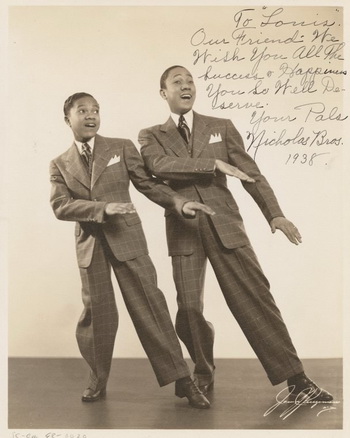
|
|
Unfortunately, the brothers’ careers were often restrained by the racism of the time, which included being limited in the film roles they were given. Unlike their
dancing peers such as Fred Astaire and Gene Kelly,
they were never given the chance to use their acting
and singing abilities in main roles. Hollywood often
gave them “flash dancing” sequences, but rarely character parts. Apparently, part of the reason for this is
that film censors in the southern USA (still enforcing
“Jim Crow” segregation laws) wanted the ability to cut
out the brothers’ act as it was felt that the Caucasian
audiences of the time would not tolerate black entertainers in their movie theatres! It is partially for this
reason that they are not as well known today. However,
over time they were able to supersede their status and
elevate African-American performers to a higher level.
In an interview clip I saw, Fayard talked about how he
arrived at a night club he was supposed to perform at, and the
black
doorman
would not
allow him
into the
theatre
because
of his colour. He
had to use
the rear
entrance,
even
though he
was the
star act!
The Nicholas brothers were
only allowed to
mingle with their white night club audiences after their
performances. Often they were told to remain in their
dressing rooms until show time.
There is an excellent article by writer Jack Marshall,
“Justice For The Nicholas Brothers, Again” that was posted on October 30, 2015. It reads in part:
The Nicholas Brothers were, you see, the greatest tap-dancers who ever lived, and the most amazing dance
team that ever will be. The fact that they have been virtually forgotten is accountable to several factors, among
them that the movies they appeared in are all about as
well-remembered as “Sun Valley Serenade” (Glenn Miller’s first film); that their films, except for one, were in
black and white; that they were primarily stage performers, and that they seldom appeared on television, and
were past their primes when they did. The main reasons
the Nicholas Brothers are forgotten, however, is that
they were black, and they were so much better than the
white dancing stars who were their contemporaries.
The team’s best numbers were in all-black cast musicals, and when they were in a movie with white stars,
their routines were slotted in so they could be easily excised when the film was playing in the South.
Even though their wizardry on the dance floor was openly acknowledged in the movie industry at the time, and
though Hollywood couldn’t resist using them, their talents were kept intentionally obscure, so no one would
find out that two short, almost indistinguishable young
men from Philadelphia could make Fred, Gene, Donald
and Ray look like they were dancing in galoshes. When
Gene Kelly or Fred Astaire were asked the question
“Why didn’t you have the Nicholas Brothers do a number
in any of your movies?,” their responses were roughly,
“Do you think I’m crazy?”* and “Have you seen the Nich-
olas Brothers?”
There were many tributes to Fayard and Harold in their
twilight years (Fayard died in 2006; Harold in 2000),
when all the right things were said about them, and they
never seemed to betray much bitterness about their careers, which I always found endearing and remarkable…
In the admittedly narrow case of the Nicholas Brothers—I
recognize that tap-dancing isn’t going to save the
world—racism robbed millions of Americans of the special, transcendent joy of seeing human beings defy natural laws to music, and two brilliant dancers/artists/
athletes of the recognition, riches and cultural immortality they earned and deserved. It is all so wrong.
The wonderful thing about the Nicholas Brothers is that
they really are unforgettable, if we only give ourselves
the chance to remember them.
The full article is available here: https://ethicsalarms.com/2015/10/30/justice-for-the-nicholas-brothers-again/
Let’s move on to the movie that first introduced me to
the Nicholas Bros: “Orchestra Wives” of 1942. Twentieth
Century Fox wanted to capitalize on the arguably most
popular band of the time: The Glenn Miller Orchestra.
It’s a flimsy plot that demonstrates the hard travel life
of a big band. The climax has Miller performing one of
his latest hits “I’ve Got A Gal In Kalamazoo”. Once the
band and singers finish, the camera pans to the Nicholas Bros. who add a few of their own verses to the song
and then go into their flash dance act. In the beginning
of the tune we see a young Jackie Gleason on stand-up
bass and Caesar Romero as the piano player. The singers are Tex Beneke and Marion Hutton with The Modernaires. This routine by the brothers was probably typical of their night club act (in the film they are also
shown to be in front of a dinner/club setting). What a
performance the audience would have seen! The video
clip is available here: https://www.youtube.com/
watch?v=fFv_PoZ2iP0
In researching this article I found that there were a
couple of 78’s issued by them, and in the late 1950’s
several LP albums. You can easily check Discogs for a
listing of their records, but they are rather minimal and
likely very hard to come across. The majority of recordings appear to have been issued in the 1950’s and
early 1960’s, when the brothers were in an almost
semi-retired state. I suspect they were not huge sellers
at the time. https://www.discogs.com/artist/584896-
The-Nicholas-Brothers
Still shot from the movie “Stormy Weather”
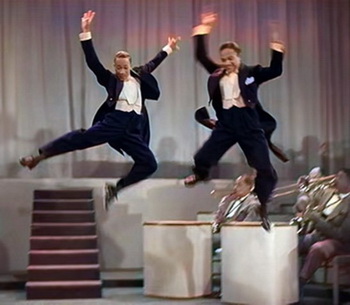
|
|
I concluded my CAPS presentation by watching a portion of a 1943 film called Stormy Weather. It was an
“all coloured” production that included
many brilliant African-American stars of
the time: Lena Horne, Bill Robinson, Fats
Waller, Cab Calloway and concludes with a
performance by the Nicholas Bros. (Harold
age 22, Fayard age 29 by this time).
Wikipedia says in part: “Stormy Weather is
a primary showcase of some of the leading
African American performers of the day,
during an era when African American actors and singers rarely appeared in lead
roles in mainstream Hollywood productions... Stormy Weather takes its title from
the 1933 song of the same title, which is
performed almost an hour into the film. It
is loosely based upon the life and times of
its star, dancer Bill "Bojangles" Robinson…
Despite a running time of only 77 minutes,
the film features some 20 musical numbers. This was Robinson's final film (he
died in 1949); Waller died only a few
months after its release.”
There is a reason that the producers saved
the best for the last: the film concludes with a scat
song by Cab Calloway and His Orchestra, and then in
jumps the two Nicholas Brothers for what many people
view as a dance that was the apex of their career. The
sequence was unbelievably filmed in only one take
(although multiple camera angles were used)! Fred
Astaire stated of the dance sequence: “it is the greatest dance number I have seen on film”.
I can’t stress strongly enough that you owe it to yourself to watch this film clip. Please take a few minutes
to view this one video and you’ll be hooked on The
Nicholas Brothers as I and so many others have been.
You will be truly amazed! Available here: https://
www.youtube.com/watch?v=IoMbeDhG9fU
The Nicholas Brothers seemed to have peaked in the
mid to late 1940’s, but continued performing in some
form or another well into the 1990’s. They appeared on
many early TV shows (such as Ed Sullivan, Dean Martin, Ann Margaret etc.). There are many kinescope TV
films available of these performances. It’s interesting
to see how versatile and dexterous they were even in
their later years, but by this time the two were living on
separate continents: Fayard in California, and Harold in
Paris. There are also many interviews available, and I
noticed that the older Fayard was always the more talkative one, and seemed to enjoy the attention. Perhaps
Harold was just used to following his older sibling’s instructions all his life, so he tended to stand back from
the microphone more?
As part of the work in their “golden years”
the brothers taught the craft to others in
the field. Some of their students were
two relatively unknown singer/dancers:
Janet and Michael Jackson! (Hmm, now I
know where “The Moon Walk” originated
from!). Watch a video of Michael Jackson
and you can see some Nicholas moves in
there.
Harold, the younger of the two passed
away at age 79 on July 3, 2000 of a heart
attack following minor surgery. Fayard
lived to be 91 and passed on January 24,
2006 of pneumonia.
After my presentation at CAPS I received
this perceptive comment from one of our
members, Don Colvin. He pointed out: “One of the
great things about the Nicholas brothers is they broke
from tradition. Notice that the Ritz Bros. , Fred Astaire
etc. (all) dance traditional tap style .The core of the
body doesn't move, only (the) legs and arms. Not so
with the Nicholas Bros. (They had a) totally unique
style.” Excellent point Don.
I hope you have enjoyed this short overview of the
Nicholas Brothers. There are so many additional dance
segments available on line, if you want to explore them
more deeply. They were truly an amazing natural talent
that unfortunately are not that well known today, in
part due to the overt racism they had to overcome and
endure throughout most of their career. Fortunately
the many performances that were filmed are preserved
and available on You Tube today to be admired for generations to come.
Addendum: There’s also a good documentary from
1992 called “We Sing, We Dance” which is about the
Nicholas Brothers lives (with many interviews), also
worth watching: https://www.youtube.com/watch?
v=67K5-9xcKwg
Enjoy!
|